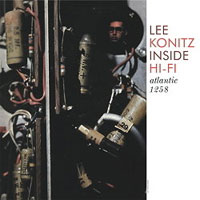Lee Konitz • Inside Hi-Fi
 ee Konitz was born in 1927, making
the now 91-year-old alto saxophonist one of the few remaining legends from jazz’s
golden age still alive and making music. Konitz has seen and played it all. He was there
for Miles Davis's Birth of the Cool sessions in the 1940s, he studied under and
played with Lennie Tristano, and he recorded a string of albums with fellow Tristano pupil
Warne Marsh (with whose cool-jazz style he shared a wonderful affinity). More recently, he
has recorded with such up-and-comers as then-teenage alto saxophonist Grace Kelly. ee Konitz was born in 1927, making
the now 91-year-old alto saxophonist one of the few remaining legends from jazz’s
golden age still alive and making music. Konitz has seen and played it all. He was there
for Miles Davis's Birth of the Cool sessions in the 1940s, he studied under and
played with Lennie Tristano, and he recorded a string of albums with fellow Tristano pupil
Warne Marsh (with whose cool-jazz style he shared a wonderful affinity). More recently, he
has recorded with such up-and-comers as then-teenage alto saxophonist Grace Kelly.
For a player who cut his teeth in the 1940s, Konitz is one of the few alto players not caught up in imitating Charlie Parker. Instead, Konitz took his own path on the alto (Parker’s instrument) with his cool playing style and acerbic, angular tone. This album, recorded by Rudy Van Gelder (RVG) in 1956, puts Konitz in a somewhat unique setting. Side one has Konitz on his familiar alto sax, except for the second solo on the album's opening track, "Kary’s Trance," where he switches to tenor sax. Then, we’re treated to an entire side of Konitz on tenor. Konitz notes here that while he enjoyed playing tenor, it’s not something he planned to continue, as he felt that all he’d end up doing was using the tenor's richer tone to express what he would normally do on the alto. Perhaps as a nod to Konitz's use of both the alto and tenor, each side features its own ensemble as well. Side one has Konitz with guitarist Billy Bauer handling color work, Arnold Fishkind on bass, and Dick Scott on drums. On side two, he uses a group of musicians he was more used to playing with: Sal Mosca on piano, Peter Ind on bass, and Scott on drums. Again, this is an RVG recording, not a usual occurrence for Konitz. Although it was recorded in September 1956 and was originally a mono issue, it is here reissued as a stereo disc, and one that sounds darn good for such an early effort (kudos to Ray Staff’s mastering work) and very quiet (not surprisingly, it’s a Pallas pressing). While the alto cuts show Konitz at his usual best, it’s the tenor side that makes this recording one you’ll want to hear. The added richness of the larger instrument suits Konitz, and after hearing his playing, you may wish, as I did, that Konitz had used tenor sax a bit more. Just listen to the opening track on side two, "Star Eyes," as an example. You hear Konitz as you’d expect, except the tone of his playing is deeper and richer, and it has a splash more color. It’s still Konitz, while at the same time sounding singular and new. Sonically, given that this is an RVG recording (albeit for Atlantic), you pretty much know what you’ll get. Konitz's sax, whether alto or tenor, is placed up front, with the rest of the band clearly behind him. Yes, due to the recording date, this is very much a left-right presentation with not much in the middle, but the channels blend well enough to keep interest. Bauer’s guitar is lighter in tone than Mosca’s piano (which sounds like a typical RVG-recorded piano). Bass is deep, and when given the chance to solo, tight and woody. It’s only the drums that seem to suffer a bit here. They're not especially clear, but the cymbals have enough shimmer to help complete the illusion. Inside Hi-Fi is an album any self-respecting jazz
lover should want as part of his or her collection. It presents one of our last remaining
links to jazz’s glorious past in his prime years and gives us Lee Konitz as we
seldom get to hear him, both on his usual alto and on tenor saxophone. That alone makes
this a worthwhile purchase. Then there’s the bonus of stereo sound, which is icing on
the cake. |
